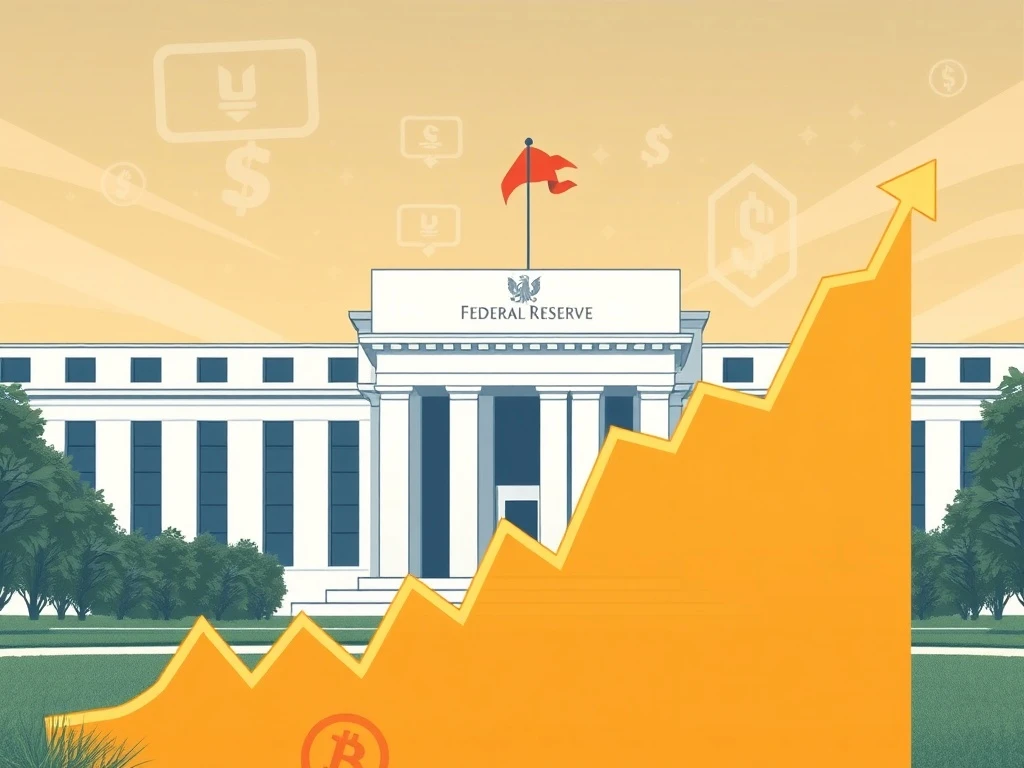Federal Reserve’s Unwavering Stance: 97.4% Market Consensus Forecasts July 2025 Rate Hold

In the dynamic world of finance, where every whisper from a central bank can send ripples across markets, the upcoming July 2025 Federal Reserve meeting stands out for its surprising lack of suspense. For cryptocurrency enthusiasts and traditional investors alike, the message is clear: stability is the name of the game. A near-unanimous market consensus points to the Federal Reserve maintaining its current federal funds rate range of 4.25%-4.5%, signaling a period of anticipated calm for the economy and potentially, for digital assets.
Why is the Federal Reserve Holding Rates Steady?
The decision by the Federal Reserve to likely keep interest rates unchanged isn’t arbitrary; it’s a calculated move based on a careful assessment of economic indicators. Analysts point to a few critical factors:
- Resilient Labor Market: Despite earlier concerns, the U.S. labor market has shown remarkable strength, with robust job growth and low unemployment rates. A strong job market often suggests underlying economic health, reducing the urgency for the Fed to stimulate growth through rate cuts.
- Inflation Metrics: While inflation has moderated from its peaks, it remains a persistent concern for the central bank. The Fed’s dual mandate includes price stability, and maintaining current rates allows them to continue monitoring inflation trends closely without prematurely easing monetary policy.
- Cautious Approach: The Fed has consistently emphasized a data-dependent approach. With rates unchanged since December 2024, extending this period of stability reflects a desire to observe the full impact of previous rate hikes on the economy before making any new adjustments. This cautious stance aims to avoid both overheating the economy and triggering an unnecessary downturn.
This period of stability reinforces the central bank’s commitment to its long-term economic goals, prioritizing a measured response over reactive policy shifts.
Understanding the Market Consensus: What Do the Indicators Say?
The confidence in a rate hold is not just anecdotal; it’s deeply rooted in sophisticated market tools and prediction platforms. The numbers paint a compelling picture:
- CME Group’s FedWatch Tool: This widely referenced benchmark, a go-to for policy expectations, assigns an overwhelming 97.4% probability of the Fed maintaining its current rate range. This figure is a strong indicator of where institutional money and smart bets are placed.
- Polymarket’s Prediction Market: Aligning closely with traditional financial tools, the cryptocurrency prediction market Polymarket forecasts a 96.3% chance that the Fed will refrain from altering rates. This cross-platform consistency underscores a broad consensus across different investor demographics.
- Minority View: The probability of a 25-basis-point cut remains marginal, at a mere 2.6% according to the FedWatch tool. This minimal appetite for immediate cuts highlights the market’s alignment with the Fed’s current trajectory.
Various news outlets and platforms corroborate these figures, reinforcing the broad agreement across the financial world. For instance, Binance’s coverage notes a 95% probability of inaction, further cementing the expectation.
Market Probability Overview for July 2025 FOMC Meeting
| Source | Predicted Action | Probability |
|---|---|---|
| CME FedWatch | Rate Hold | 97.4% |
| Polymarket | Rate Hold | 96.3% |
| Binance Coverage | Rate Hold | 95% |
| CME FedWatch | 25-bp Cut | 2.6% |
Impact of the FOMC Decision on Crypto and Broader Markets
The implications of the upcoming FOMC decision, or rather, the anticipated non-decision, extend far beyond the Federal Reserve’s meeting rooms. For both traditional and digital asset markets, this stability is a significant factor.
- Muted Volatility: In anticipation of the widely expected rate hold, market indices and gold prices have shown muted volatility. This reduced uncertainty allows investors to plan with greater confidence, leading to less erratic price movements.
- ‘Risk-On’ Mood in Equities: Topstep’s analysis highlights a prevailing “risk-on” mood in equities, evidenced by the S&P 500 gaining 1.44% in the prior week. This suggests that investors are comfortable taking on more risk, potentially seeking higher returns in growth-oriented assets, as the economic outlook appears stable.
- Implications for Crypto: While the direct correlation between Fed rates and crypto can be complex, a stable interest rate environment generally fosters a more predictable macro-economic backdrop. This can reduce overall market uncertainty, potentially encouraging investment into riskier assets like cryptocurrencies. When traditional markets are calm and showing a ‘risk-on’ sentiment, it often creates a favorable environment for crypto to thrive, as investors seek diversification and higher potential returns.
Even with external voices, such as BlackRock’s chief investment officer, publicly urging rate cuts, the data-driven forecasts remain steadfast in their predictions of inaction, indicating that market participants are largely pricing in the Fed’s current trajectory.
Navigating Future Interest Rates: What’s Next?
While the July 2025 meeting appears to be a foregone conclusion regarding the interest rates, the financial world’s gaze will quickly shift to what comes next. The focus will undoubtedly turn to the Federal Reserve’s forward guidance.
- Jerome Powell’s Remarks: Investors will scrutinize Fed Chair Jerome Powell’s post-meeting remarks for any subtle clues about future rate path adjustments. Even if rates remain unchanged, Powell’s commentary on inflation, employment, and economic projections will be critical in shaping market expectations for the latter half of 2025.
- Data Dependency: The Fed’s commitment to data dependency means that any future policy adjustments will hinge on evolving economic conditions. Market participants will be closely watching upcoming inflation reports, labor market statistics, and GDP figures for signs that could trigger a shift in the Fed’s stance later in the year.
- Potential for Later Adjustments: While an immediate cut is off the table, the possibility of rate adjustments in Q3 or Q4 2025 remains a topic of discussion. The market is constantly re-evaluating these probabilities based on incoming data, but for now, the stability is a welcome constant.
Tools like the FedWatch are crucial for gauging these policy expectations and are instrumental in shaping market strategies, as noted by financial news outlets like TheStreet and Investopedia.
The overwhelming consensus for a Federal Reserve rate hold in July 2025 signals a period of anticipated stability in the financial markets. Driven by a resilient labor market and ongoing inflation concerns, the Fed’s cautious approach is clearly reflected in the high probabilities from tools like CME FedWatch and Polymarket. For investors, this means reduced uncertainty, a ‘risk-on’ mood in equities, and a potentially more predictable environment for digital assets. As the July 30 meeting approaches, the focus will shift from the immediate decision to the Fed’s forward guidance, offering crucial insights into the future trajectory of monetary policy.
Frequently Asked Questions (FAQs)
What is the Federal Funds Rate?
The federal funds rate is the target interest rate set by the Federal Reserve. It’s the rate at which commercial banks borrow and lend their excess reserves to each other overnight. It serves as a benchmark for other interest rates in the economy, influencing everything from mortgage rates to credit card interest and, indirectly, the cost of borrowing for businesses and consumers.
What is the CME FedWatch Tool?
The CME FedWatch Tool is a widely used online resource that provides probabilities of future Federal Reserve interest rate changes. It does this by analyzing the pricing of federal funds futures contracts traded on the CME (Chicago Mercantile Exchange) Group. It’s a real-time indicator of market expectations regarding the Fed’s monetary policy decisions.
How do Interest Rates Affect Cryptocurrency Markets?
While not directly tied, interest rates can indirectly affect cryptocurrency markets. Higher interest rates can make traditional investments (like bonds or savings accounts) more attractive, potentially drawing capital away from riskier assets like cryptocurrencies. Conversely, lower interest rates or a stable rate environment can make riskier assets more appealing, as investors seek higher returns. A stable rate environment, as expected in July 2025, can reduce macro-economic uncertainty, which is generally positive for risk assets like crypto.
Why is the Federal Reserve prioritizing a Rate Hold?
The Federal Reserve is prioritizing a rate hold primarily due to a resilient labor market and persistent, albeit moderating, inflation. By maintaining the current rate, the Fed aims to ensure price stability and allow previous rate hikes to fully impact the economy without prematurely stimulating demand or risking a resurgence of inflation. It’s a cautious, data-dependent approach.
What is “Forward Guidance” from the Fed?
Forward guidance refers to the communication from the Federal Reserve about its future monetary policy intentions. This includes statements, speeches, and projections that offer clues about the likely path of interest rates and other policy tools. It’s a way for the Fed to influence market expectations and financial conditions without necessarily changing rates immediately, providing clarity and reducing uncertainty for investors and businesses.









